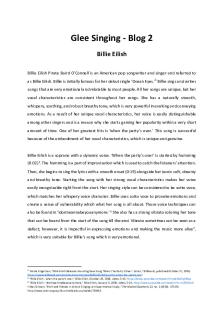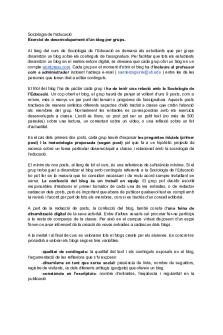Glee singing blog 2 PDF

| Title | Glee singing blog 2 |
|---|---|
| Course | Glee Singing |
| Institution | University of Melbourne |
| Pages | 4 |
| File Size | 194.1 KB |
| File Type | |
| Total Downloads | 112 |
| Total Views | 155 |
Summary
This is the second entry of the blog assignment. Got an H1...
Description
Glee Singing - Blog 2 Billie Eilish Billie Eilish Pirate Baird O'Connell is an American pop songwriter and singer and referred to as Billie Eilish. Billie is initially famous for her debut single ‘Ocean Eyes.’1 Billie sings and writes songs that are very emotional and relatable to most people. All her songs are unique, but her vocal characteristics are consistent throughout her songs. She has a naturally smooth, whispery, soothing, and robust breathy tone, which is very powerful in evoking and conveying emotions. As a result of her unique vocal characteristics, her voice is easily distinguishable among other singers and is a reason why she starts gaining her popularity within a very short amount of time. One of her greatest hits is ‘when the party's over.’ This song is successful because of the embodiment of her vocal characteristics, which is unique and genuine.
Billie Eilish is a soprano with a dynamic voice. ‘When the party's over’ is started by humming (0:02)2. The humming is a part of improvisation which is used to catch the listeners' attention. Then, she begins to sing the lyrics with a smooth onset (0:19) alongside her iconic soft, dreamy and breathy tone. Starting the song with her strong vocal characteristics makes her voice easily recognizable right from the start. Her singing style can be considered to be sotto voce, which matches her whispery voice character. Billie uses sotto voce to provoke emotions and create a sense of vulnerability which what her song is all about. Those voice techniques can also be found in ‘idontwannabeyouanymore.’ 3 She also has a strong vibrato coloring her tone that can be heard from the start of the song till the end. Vibrato sometimes can be seen as a defect; however, it is impactful in expressing emotions and making the music more alive4, which is very suitable for Billie's song which is very emotional.
1
Nicole Engelman, “Billie Eilish Releases Haunting New Song ‘When The Party’s Over’: Listen,” Billboard, published October 17, 2018, https://www.billboard.com/articles/columns/pop/8480413/billie-eilish-when-the-partys-over 2 “Billie Eilish - when the party’s over,” Billie Eilish, October 26, 2018, video, 3:13, https://www.youtube.com/watch?v=pbMwTqkKSps 3 “Billie Eilish – idontwannnabeyouanymore,” Billie Eilish, January 5, 2018, video, 3:24, https://www.youtube.com/watch?v=-tn2S3kJlyU 4 Max Schoen, "Pitch and Vibrato in Artistic Singing: An Experimental Study," The Musical Quarterly 12, no. 2 (1926): 275-90. http://www.jstor.org.ezp.lib.unimelb.edu.au/stable/738463.
Billie uses the mix of both chest and head voice in singing when the party's over. Amazingly, the shift from her chest voice to head voice is very smooth (0:45-0:51). It is because of her smooth and whispery tone, making it feel indifferent. She also uses her soothing tone together with legato phrasing to add and amplify the emotions of the song. Legato phrasing is often associated with calmness and sadness because of the smooth note transitions 5, which is similar to Billies' soft and breathy voice tone. Combining both legato phrasing and her voice characters make a perfect combo because during the live performance 6, the song successfully makes her listeners quiet the entire song as if it soothed her listeners' souls. The reaction of the listeners is totally different with her upbeat song such as "you should see me in a crown"7 where she uses rhythmic phrasing, and everybody just dance and sing along.
In the chorus, Billie uses Riffs (0:59-1:14). The lyrics of "I could lie, and say I like it like that, like it like that" are repeated in order to amplify the emotion, which is the feeling of loneliness that most people struggle sometimes. She uses scoops as well in building up the riffs. Here, Billie successfully conveys the emotion of the music to the listeners. At the outro, Billie uses a stronger sotto voce (2:42) 8. The reason is to indirectly tell the audience that the song will end soon. By using a stronger sotto voce, it makes her voice more and more vulnerable. Then, she ends the song with an aspirate offset (3:04). Overall, her voice characters are unique; not only shaping the atmosphere of her song but also making her voice memorable and easily recognized.
5 Malinda J. McPherson et al., “The Role of Emotion in Musical Improvisation: An analysis of Structural Features,” PLoS One 9, no.8 (2014): e105144, doi: 10.1371/journal.pone.0105144 6 “Billie Eilish - when the party’s over (Vevo LIFT Live Sessions),” Billie Eilish, November 16, 2018, video, 3:21, https://www.youtube.com/watch?v=CPmAjkREqSw 7 “Billie Eilish – you should see me in a crown – Live Performance (Vevo LIFT),” Billie Eilish, November 16, 2018, video, 3:07, https://www.youtube.com/watch?v=LIdBaYubK8I
8
“Billie Eilish – when the party’s over.”
Bibliography
“Billie Eilish - when the party’s over (Vevo LIFT Live Sessions).” Billie Eilish, November 16, 2018. Video, 3:21. https://www.youtube.com/watch?v=CPmAjkREqSw
“Billie Eilish - when the party’s over.” Billie Eilish, October 26, 2018. Video, 3:13. https://www.youtube.com/watch?v=pbMwTqkKSps
“Billie Eilish – idontwannnabeyouanymore.” Billie Eilish, January 5, 2018. Video, 3:24. https://www.youtube.com/watch?v=-tn2S3kJlyU
“Billie Eilish – you should see me in a crown – Live Performance (Vevo LIFT).” Billie Eilish, November 16, 2018. Video, 3:07. https://www.youtube.com/watch?v=LIdBaYubK8I
Engelman, Nicole. “Billie Eilish Releases Haunting New Song ‘When The Party’s Over’: Listen.” Billboard.
Published
October
17,
2018.
https://www.billboard.com/articles/columns/pop/8480413/billie-eilish-when-thepartys-over
Hazzan,
Heather.
Billie
Eilish,
2019,
https://www.billboard.com/articles/news/awards/8532480/billie-eilish-arianagrande-lizzo-front-runners-record-of-the-year-grammys-2020
McPherson, Malinda J., Monica Lopez-Gonzalez, Summer K. Rankin, Charles J. Limb. “The Role of Emotion in Musical Improvisation: An analysis of Structural Features.” PLoS One 9, no.8 (2014): e105144. doi: 10.1371/journal.pone.0105144.
Schoen, Max. "Pitch and Vibrato in Artistic Singing: An Experimental Study." The Musical Quarterly 12,
no.
2
(1926):
http://www.jstor.org.ezp.lib.unimelb.edu.au/stable/738463.
275-90....
Similar Free PDFs

Glee singing blog 2
- 4 Pages

Chapter 2- Philosophy of Singing
- 3 Pages

Blog 2 Estilo Indirecto
- 3 Pages

BLOG 1 - BLOG
- 3 Pages

Evidence Blog Pet peeves blog
- 1 Pages

Aktiviti Minggu 2 Group Blog
- 5 Pages

Blog post #2 - post 2 online
- 1 Pages

12min Blog
- 4 Pages

Exercici blog
- 2 Pages

Week5 - blog
- 6 Pages

Discussion Blog
- 1 Pages

Seth Riggs Singing for the Stars espanol
- 134 Pages

Spanish blog - Grade: A
- 1 Pages

Blog actividad 3 sena
- 2 Pages

Kopi Time - Marketing BLOG
- 7 Pages
Popular Institutions
- Tinajero National High School - Annex
- Politeknik Caltex Riau
- Yokohama City University
- SGT University
- University of Al-Qadisiyah
- Divine Word College of Vigan
- Techniek College Rotterdam
- Universidade de Santiago
- Universiti Teknologi MARA Cawangan Johor Kampus Pasir Gudang
- Poltekkes Kemenkes Yogyakarta
- Baguio City National High School
- Colegio san marcos
- preparatoria uno
- Centro de Bachillerato Tecnológico Industrial y de Servicios No. 107
- Dalian Maritime University
- Quang Trung Secondary School
- Colegio Tecnológico en Informática
- Corporación Regional de Educación Superior
- Grupo CEDVA
- Dar Al Uloom University
- Centro de Estudios Preuniversitarios de la Universidad Nacional de Ingeniería
- 上智大学
- Aakash International School, Nuna Majara
- San Felipe Neri Catholic School
- Kang Chiao International School - New Taipei City
- Misamis Occidental National High School
- Institución Educativa Escuela Normal Juan Ladrilleros
- Kolehiyo ng Pantukan
- Batanes State College
- Instituto Continental
- Sekolah Menengah Kejuruan Kesehatan Kaltara (Tarakan)
- Colegio de La Inmaculada Concepcion - Cebu
